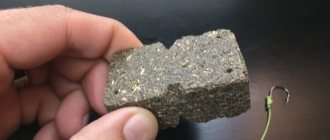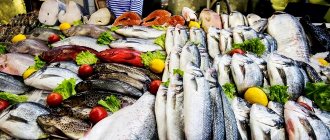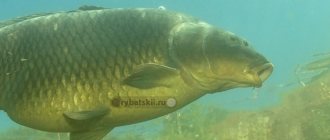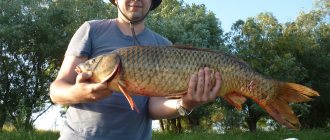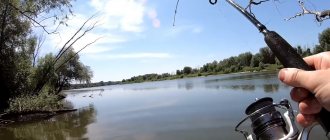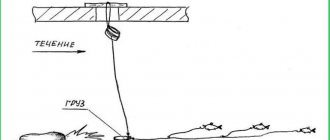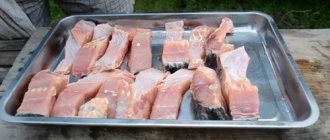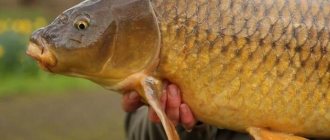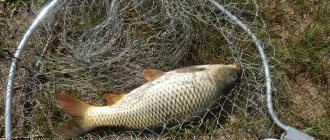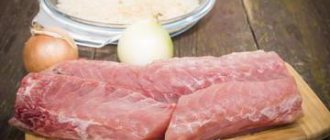Where and when to catch carp with cake
Finding carp in a reservoir is sometimes difficult, especially if you don’t know the catch spots and various features of the bottom topography, such as:
- addiction;
- elements of artificial structures located directly in the reservoir;
- construction garbage;
- spots of bottom soil different from the main one;
- artificial and natural unevenness of the bottom surface (pits and hills).
In addition, the carp loves quiet places and can be found in thickets of aquatic vegetation.
During the cold season, fish are inactive, so the optimal time to start fishing is considered to be the period when the water temperature reaches +12 degrees. Then the carp gets out of the wintering pits and looks for food. From this moment on, he begins to be interested in cake.
Fishing places and times
Since wild carp prefers to be at depth during daylight hours, its search begins with descent to the pits. Very good results are also shown in places where clear water borders areas of aquatic vegetation. Here the fish have a good view and feel safe. When it gets dark the situation changes. The carp comes out into shallow water, in areas with a weakly defined edge. At this time it can be at a depth of 1 meter.
When choosing a place to catch carp, it is very important to consider the time of day.
Varieties of rigs for carp for catching with cake
Carp has a special love for sunflowers. Fishermen have long noticed that compressed seeds are especially attractive to wild carp, and have successfully used them as bait.
Did you know? The carp does not have a stomach, but it has sharp, strong three-row teeth, with which it can easily crush even mollusk shells and literally grind plant food.
Over the years, various tackles have been invented for fishing with makukha (pressed cake), namely:
- Makushatnik with a stationary load. This design assumes that the tackle has a weight plate fixed at the end of the main line, to which the cake is attached. Leashes with hooks are tied along the edges of the load, the points of which are hidden in the bait. When a fish feasts on the top, it grabs the hooks, believing that it is bottom debris that carp pass through their gills. The fisherman can only hook and catch the fish.
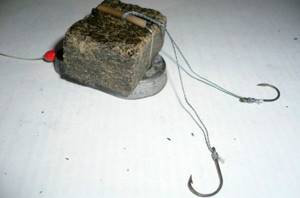
- Sliding weight equipment. In this option, it is assumed that the load will move on a fishing line, so you need to choose a model that has a longitudinal hole. The load is placed on a fishing line and secured on both sides with stoppers. The distance between them should be 15–20 cm. A through hole is made in the center of the top of the head, through which the bait is attached to the fishing line. The free end must be shaped into a loop, into which a ring with leashes and hooks is then attached.
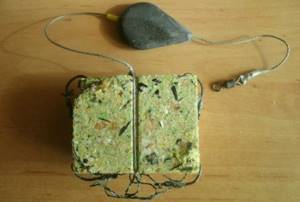
Features and types of equipment
There are 2 types of equipment for carp:
- with a sliding sinker. This type of equipment is used when fishing aimed at carp takes place on a river with a current. This is due to the fact that when the fish begins to savor the cake, it does not feel resistance and, as a result, is not afraid. In this case, you need to hang restrictive elastic bands or beads for the load so that the fish hooks itself after it swallows the hooks;
- deaf option. It is used when fishing for carp in ponds and rivers, with standing water or extremely slight current.
The essence and types of cake
Privads of this type are a by-product of the process of obtaining vegetable oil, the pressed mass of which is pressed into dense blocks and supplied to retail fishing outlets in the form of layers for further cutting into the required sizes or already packaged briquettes. The compressed substance has a persistent aromatic odor from oil residues and when placed in water for a long time, it begins to decompose into small particles and release fine turbidity.
Read more about what fishing cake is and how you can prepare it yourself.
Cake fishing is based on supplying the above-described bait to the fishing point, including several hooks on short leashes. When a fish approaches the smell, it begins to suck on the tasty briquette and in this process absorbs the hooks, thereby becoming a fishing trophy. Briquettes made from sunflower seeds have become widespread. They occupy the bulk of the product among the tops. But there are also varieties made from flaxseed and soybean seeds, which are more expensive than the sunflower product, but are also effective in practical use.
Making makushatnik
The gear that is used on carp is very simple and anyone can make it. It consists of the following elements:
Main plate
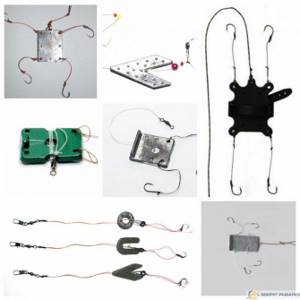
The material for its manufacture can be thick, strong plastic, lead or steel. The use of other materials is also possible, but these are the most affordable. Heavier ones (lead, steel) are used when fishing with strong currents. In standing water, it is better to use lightweight plastic plates.
It will be necessary to drill several holes in these plates, depending on how many leashes you want to attach in the future. It would also be correct to do them to attach the bait itself. Usually about ten holes are enough.
Leash
Leads with a length of about 5–7 cm are considered optimal. They are made from monofilament or braided fishing line with a thickness of 0.35 mm. The leashes are attached to a special fastener, which is sold in any fishing store, on the back of the plate or directly into the holes made in the plate.
Hooks
In order for the caught carp to successfully reach the shore, use the right strong hooks. It is better to use carp from No. 4 to No. 6. The number is selected based on the size of the expected prey.
Cargo
The sinker is used in any shape, but the most common is the name “dovetail”. Thanks to its good aerodynamic performance, it can be thrown further than others. The weight of the load is selected individually and varies from 60–80 grams for standing water to 80–180 grams for rivers with a strong current.
fishing line
For confident carp fishing, it is enough to use a fishing line with a diameter of 0.45 mm and a length of about 100 m. In this case, the best option would be to use monofilament fishing line.
This is enough to collect the top of a carp, which is cast manually or using a rod equipped with a reel. The form must be strong, the test must correspond to the weight of the load with the top. There are no other requirements for the rod; when fishing with a rod, it allows you to cast further and make it easier to fight the trophy when fishing. Everyone chooses the length based on their height, experience and preferences.
You need to be careful when choosing a reel, since it will bear a large load when reeling out a heavy load and wet tops. The carp will also add tension to the reel, he is a great fighter and the jerks will be strong. It’s better to choose a size 3500–4000 with a well-adjustable friction brake, preferably a front one, this will make the fishing process easier. It would also be useful to have a baitrunner; the carp bites very actively after hooking.
Fishing on the top of the head

Carp spends most of its time near the bottom; promising places for catching it are considered areas of the reservoir where the depth is from 2.5 to 4 m. Also, special attention should be paid to holes, depth changes, and edges - these are the favorite habitats of prey.
It is recommended to choose places near reed thickets, but there should be no algae, snags or grass at the bottom. Having caught on the hook, the carp will try to free itself from it as quickly as possible and go under the snag, where it will be problematic to get it. Another important nuance when choosing a place: the bottom surface must be hard, without a layer of silt, so that the smell of the bait is not interrupted by silt.
The makushatnik is effective both for daytime fishing and at night. Fishing during the day allows the fisherman to more carefully observe the gear, and when fishing, he does not get caught on stones or snags on the shore. Advantages of night fishing: the bite is more intense, the prey is larger. If fishing occurs at night, the place on the shore should be level, without obstacles, in particular stones.
The specific smell of makha has a rather strong effect on the object of fishing, but to increase the effectiveness of fishing, preliminary feeding from grain crops (corn, peas, wheat) is used.
After feeding, you need to cast the tackle, wait until the top gets wet, and watch the rod. It is recommended to change the bait every 2 hours.
The fishing process consists of:
- Detection of the proposed bait by carp. The fish approaches the cake with hooks, examines it and begins to taste it with caution. At this moment, the rod twitches slightly, which signals an upcoming bite.
- Having swallowed a hook with bait, the fish immediately tries to go to cover. After a sharp jerk, the clutch on the reel is activated, which allows the fishing line to freely come off the spool. The main thing is not to miss the moment and make the cut in time.
- The fishing process must be carried out carefully, without sudden movements , otherwise, having torn the lip, the carp will be able to get off the hook. After a little time, the prey will get tired and it will be easier to pull it to the shore. To be on the safe side, it is recommended to use a large landing net.
At night, there should not be a lot of light on the shore, and the bait used is more intense than during the day.
https://www.youtube.com/watch?v=aBe5HPpb23o
How to choose the right makuha
The issue of choosing makukha is approached with all seriousness, since the success of fishing depends on it. Makha is a cake from the seeds of plants that produce oil through pressing. That is, the raw material for its production can be any seeds containing oil. But the most widely used in fishing is sunflower seeds, due to its availability and low cost. When choosing it, pay special attention to the following indicators:
Hardness
Depending on where you are fishing for carp, you need to choose the right top hardness. Soft is used when fishing in still water. This is due to the fact that it will quickly begin to become limp (in about an hour and a half), forming a spot of bait, and the fish will sooner smell it and come up to try it. When purchasing, pay attention to the fact that the soft top should crumble a little, and if you knock a piece on the table, it will make a dull sound.
Medium-hard fluff is used in bodies of water with little current. It will take two to four hours for the top to become limp. Such dust should practically not fall out, and when knocking it makes a sound closer to a ringing one.
Hard top. This fly is suitable for fishing in reservoirs with strong currents, as it will stay on the rig for a long time (4-6 hours) and attract fish to one point. This type of muffin makes a clear, ringing sound and does not crumble.
There is another version of makukha - alluvial. It is used for mixing groundbait, or it is made into a dense dough and used in a fish tank, although this is only possible in stagnant water.
The above indicators are relevant for summer. In the cold season, when the carp fishing season just opens, the disintegration time of the makukha increases by one and a half to two hours. Therefore, it is better not to use hard powder at this time.
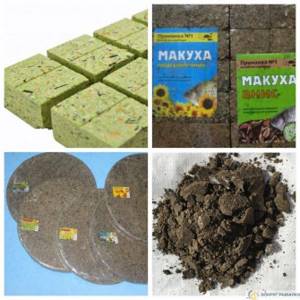
Freshness
You can smell and taste the makukha before purchasing. High-quality cake has a sweetish taste. If the top is bitter or rotten, then you should not take it, as the fish will not be interested in it. There are also briquettes packed in film. Here you can judge only by the date of manufacture.
For greater aroma and resistance to deterioration, soak the top with oil. If you just dip and pull out, it will add an hour. Soak until air bubbles appear, then consider that you have added four hours of durability.
Types of macaques
In fishing stores you will find the following types of makukha:
- sunflower. This type is most widespread due to its low cost and availability at points of sale. It has a pronounced aroma and pleasant taste;
- linen The cost of such waste will be high due to the complexity and non-mass production;
- soy. At points of sale, such muck is rarely found. The advantage of this type is its high protein content.
Selection and arrangement of gear
To catch carp using cake, you need to arrange the tackle correctly. A modern carp feeder or feeder rod is used as the basis. However, many fishermen successfully use other fishing rods for this, for example, the Chinese indestructible spinning rod of the “Crocodile” type.
Catching a carp with a makushatka means fighting with serious fish when fishing, so you shouldn’t be too fussy when choosing a reel. In this case, it is best to equip the fishing rod with an inertia-free “meat grinder” with a baitrunner, which will not allow a strong opponent to drag your rod into the water. A sufficient supply of monofilament fishing line with a diameter of 0.28 to 0.40 millimeters is wound onto the spool, 50-100 meters long.
Attention! The use of braided fishing line in carp fishing is not recommended due to its low elongation coefficient.
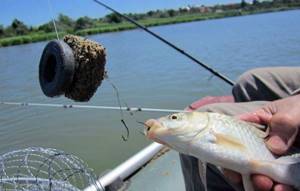
By-catch on the top of the pond may include roach, bream and other carp fish
Fishing technique and tactics
To catch carp in the selected body of water, adhere to the following rules:
- after casting the bait, secure the rod, as the fish bites sharply and strongly;
- add the bait mixture from time to time;
- You should not immediately try to pull the carp ashore. He needs to be worn down. You need to gradually pull him up until he resists, and let him go when the struggle intensifies;
- If a fish goes under a snag, you should not try to pull it out right away. It’s better to put the rod down and wait until she comes out on her own;
- take a landing net with you. It is not uncommon for fishermen to lose their catch already on the shore, since even a tired carp will try to make the final push.
Top system
The principle of operation of the makushatnik tackle is that the top, which is tied, falls to the bottom of the reservoir and gradually gets wet. As a result, small particles begin to blur, which attract underwater inhabitants.
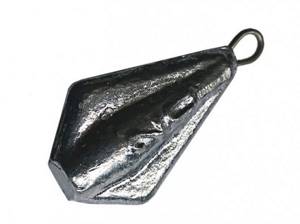
The makha also gives off an interesting smell of roasted sunflower. Since fish have a good sense of smell, this is also an excellent factor for successful fishing.
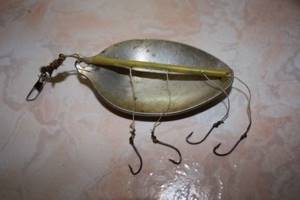
After the joyful fish discovers the pieces of tackle, it begins to slowly suck them in and the hook gets into its mouth with them.
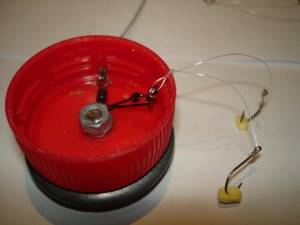
The time it takes for the fish to start biting is determined mainly by the quality of the top and how well it is compressed.
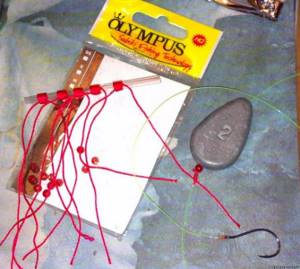
The rate at which the food breaks down into pieces is also important. Sometimes it happens that a fish gets hooked within 5 minutes, but this happens extremely rarely when a fisherman throws the tackle right under its nose.
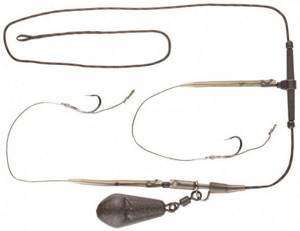
However, most often this procedure takes more than 10 minutes. Therefore, anglers usually fish with several fishing rods at once, which are equipped with top rods.
Lure
Since carp is a voracious fish, for bait use various types of boiled porridge (wheat, pearl barley, pea, corn, semolina, etc.), soaked and mashed bread crumb with a crust, as well as dough, potatoes and cake. The latter is found crumbly for ease of preparation of bait. It would also be a good idea to add pieces of dung worms and crawlings to the mixture. To make the treat more attractive, add oil to it (linseed, hemp or sunflower would be good).
If you don’t have the time or desire to cook this delicacy, then you can buy it in the store. When choosing, pay attention to the presence of amino acid complexes, flavors, as well as various vegetable oils. If necessary, combine store-bought and homemade bait to achieve good results. You need to throw the mixture based on bites. At the same time, it is important not to overfeed the fish, since after eating to its full it can simply leave.
Although carp is one of the most difficult to catch fish in the carp family, it is possible to catch it. The main thing is to approach the choice of casting location wisely, take into account the presence or absence of current in the reservoir, learn as much as possible about the bottom topography, as well as the presence of various shelters in it, such as snags, stones, etc. You need to carefully choose a high-quality mackerel, do not rush to catch the specimen you come across, and then luck will smile on you and you will finally catch your valuable trophy.
Photo of the makushatnik
Read here DIY fishing box - the best ideas and projects for building a box with your own hands (110 photos and videos)
Help the project, share on social networks 

0
Benefits of using pulp
The main advantages of cake for fishing:
- extremely attractive to fish;
- dissolves quite quickly in water, while creating a kind of tasty cloud with an appetizing smell for fish;
- very easy to make with your own hands;
- sold in any specialized store at a low price;
- Possibility of fishing during flow or in still water.
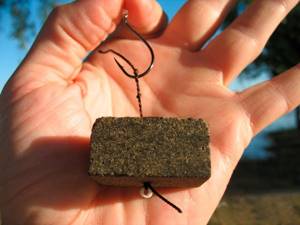
What is a makushatnik?
The main element of this equipment is a block of makukha. This is a compressed cake obtained by squeezing vegetable oil from the seeds of oil crops.
For fishing, the seeds of the following plants are mainly used:
- linen;
- sunflower;
- hemp;
- rape.
During long-term storage, the cake loses its aroma and acquires a rancid smell, so for fishing you should use only freshly squeezed and compressed cake.
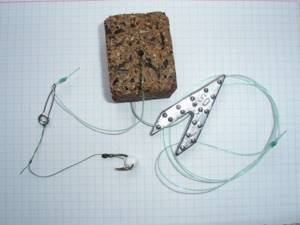
When fishing with a makushatnik, the following actions are performed:
- A block of makukha is attached to a flat plate of lead or iron using an elastic band or a self-tightening knot.
- The tip of the hook is inserted into the edges of the crown. In order to prevent breakage of the hook and make your task easier, you need to make holes for the hooks in a piece of cotton wool in advance.
- Hooks inserted into the top of the hook in advance will prevent the leashes from getting tangled when casting. Thanks to the positive buoyancy of the top, it will always be on top of the load after casting, which prevents the top from being pressed into the silt by the load, and will also ensure constant access for the fish to the bait.
During the period of late spring and early summer, when carp begins to actively search for food of plant origin and moves a lot near the bottom of the reservoir, this tackle is most effective.

